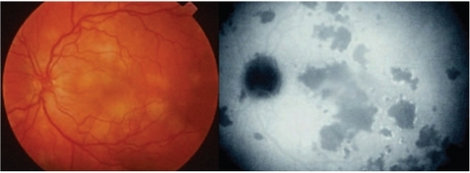Acute posterior multifocal placoid pigment epitheliopathy
| Acute posterior multifocal placoid pigment epitheliopathy | |
|---|---|
 | |
| Bilateral confluent yellowish fundus lesions | |
| Specialty | Ophthalmology |
Acute posterior multifocal placoid pigment epitheliopathy (APMPPE) is an acquired inflammatory uveitis that belongs to the heterogenous group of white dot syndromes in which light-coloured (yellowish-white) lesions begin to form in the macular area of the retina. Early in the course of the disease, the lesions cause acute and marked vision loss (if it interferes with the optic nerve) that ranges from mild to severe but is usually transient in nature. APMPPE is classified as an inflammatory disorder that is usually bilateral and acute in onset but self-limiting. The lesions leave behind some pigmentation, but visual acuity eventually improves even without any treatment (providing scarring doesn't interfere with the optic nerve).
It occurs more commonly in females and is more likely to affect persons between 20 and 30 years of age, but has been seen in people aged 16 to 40. It is known to occur after or concurrently with a systemic infection (but not always), showing that it is related generally to an altered immune system. Recurrent episodes can happen, but are extremely rare.[1][2]
Signs and symptoms
The onset of ocular symptoms are usually preceded by episode of viral or flu-like symptoms such as fever, cough or sore throat (however this is not always the case). Patients can typically present erythema nodosum, livido reticularus, bilateral uveitis, and sudden onset of marked visual loss associated with the appearance of multiple lesions in the retina. These lesions may be colored from grey-white to cream-shaded yellow. Other symptoms include scotomata and photopsia. In weeks to a month times the lesions begin to clear and disappear (with prednisone) leaving behind areas of retinal pigment epithelial atrophy and diffuse fine pigmentation (scarring). Rarely choroidal neovascularization occur as a late onset complication.[3]
Cause
The cause of the inflammation remains unknown, with various theories of it occurring as an autoimmune response to a mild infection, or the possibility of it being viral because of the preceding flu-like illness that generally accompanies it.[1][3] It is usually associated with HLA-B7 and HLA-DR2.
Diagnosis
Diagnosis is made by an ophthalmologist or optometrist during eye examination. Further tests such as fluorescein angiography or lumbar puncture are usually performed to confirm the diagnosis. Neurosarcoidosis is a similar autoimmune disorder that can be confused with APMPPE.
Treatment
Owing to the self-limiting nature of the disease, treatment is generally not required. In cases where lesions appear to be interfering with the optic nerve, methyl prednisone is prescribed.[citation needed]
Prognosis
Vision improves in almost all cases. In rare cases, a patient may suffer permanent visual loss associated with lesions on their optic nerve.
Rarely, coexisting vasculitis may cause neurological complications. These occurrences can start with mild headaches that steadily worsen in pain and onset, and can include attacks of dysesthesia. This type of deterioration happens usually if the lesions involve the fovea.[1][4]
See also
References
- ↑ 1.0 1.1 1.2 Comu, S; Verstraeten, T; Rinkoff, JS; Busis, NA (May 1996). "Neurological manifestations of acute posterior multifocal placoid pigment epitheliopathy". Stroke: A Journal of Cerebral Circulation. 27 (5): 996–1001. doi:10.1161/01.str.27.5.996. PMID 8623125.
- ↑ Jones, Nicholas P (1995). "Acute posterior multifocal placoid pigment epitheliopathy". British Journal of Ophthalmology. BMJ group. 79 (4): 384–389. doi:10.1136/bjo.79.4.384. PMC 505108. PMID 7742290.
- ↑ 3.0 3.1 De Vries, J.J. (June 2006). "Acute Posterior Multifocal Placoid Pigment Epitheliopathy With Cerebral Vasculitis: A Multisystem Granulomatous Disease - Archives of Ophthalmology". archopht.ama-assn.org/. 124 (6): 910–913. doi:10.1001/archopht.124.6.910. Archived from the original on 2011-09-27. Retrieved 2009-09-15.
- ↑ Wolf, Mitchell D; Alward, Wallace LM; Folk, James C (June 1991). "Long-term Visual Function in Acute Posterior Multifocal Placoid Pigment Epitheliopathy". Archives of Ophthalmology. 109 (6): 800–3. doi:10.1001/archopht.1991.01080060064025. PMID 2043067. Archived from the original on 2012-02-22. Retrieved 2021-04-26.
External links
| External resources |
|---|